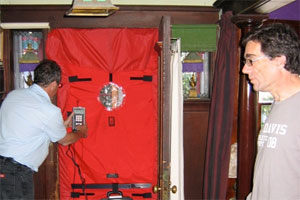 How much air is your house leaking? Are you unknowingly slurping in dirty air from your garage and attic? Perhaps a blower door test can help you find out. Tom White is the Publisher of Home Energy (aka "my boss"). He's gotten to know a lot about home performance in this job over the last few years. He knows about blower doors and pressure envelopes, duct blasters and thermal envelopes; and has been initiated into the knowledge that you never use duct tape on ducts. But there was one more initiation to go. So he went to the Web to find someone to do an energy audit on his house.
How much air is your house leaking? Are you unknowingly slurping in dirty air from your garage and attic? Perhaps a blower door test can help you find out. Tom White is the Publisher of Home Energy (aka "my boss"). He's gotten to know a lot about home performance in this job over the last few years. He knows about blower doors and pressure envelopes, duct blasters and thermal envelopes; and has been initiated into the knowledge that you never use duct tape on ducts. But there was one more initiation to go. So he went to the Web to find someone to do an energy audit on his house.
"I went to the ServiceMagic Web site that I learned about editing a Home Energy article," says Tom. "Within less than a minute after I entered some basic information about my house and what I was looking for in the way of an energy audit, the phone rang." It was Sustainable Spaces, a home performance contractor located in San Francisco. Tom made an appointment for his audit for the next week. "They were offering a 'Stimulus Special' for $395."
The house Tom shares with his partner Dmitri was built in 1907. "The home has never been remodeled," says Tom. "We recently had the furnace replaced with a hot water radiant system. We have been careful to keep to the original features of the home, so we got our radiators from buildings built around the same time that used to be part of the heating systems in buildings at Fort Baker." They also installed a renewable energy source. "We installed photovoltaic (PV) panels on our roof, but we should have had the audit first to show us how to use less energy and save on the PV. Our annual true-up statement says we owe $75 for electricity, but I want to get that down to $0!"
Rob Mitchell, an experienced contractor who knows a lot about Bay Area houses, came with two younger men for an audit of Tom and Dmitri's 102-year-old home. The crew closed all the exterior doors and windows, installed a "blower door" in the main doorframe, and depressurized the house. Immediately, dust and insulation particles began to pour through the "pocket doors" from the attic. After taking some measurements to get a general sense of how leaky the house is, and blocking some of the major air leaks, the crew from Sustainable Spaces then pressurized the house. "We walked around the house with a liquid pencil, which showed there is airflow around switch plates, gaps in the baseboard where the home is connected to the outside, and the cabinet in our kitchen where there used to be 'torpedo tubes,' which used to hold hot water heated by the wood stove, and other places" says Tom.
So the old house has some problems with air leakage, which means heating energy being lost to the outside. The crew also found out that the humidity in the kitchen was 20% higher than that on the outside of the house. "We both took showers that morning, and I had a cup of hot tea," says Tom. That was enough to keep the humidity high a few hours later.
